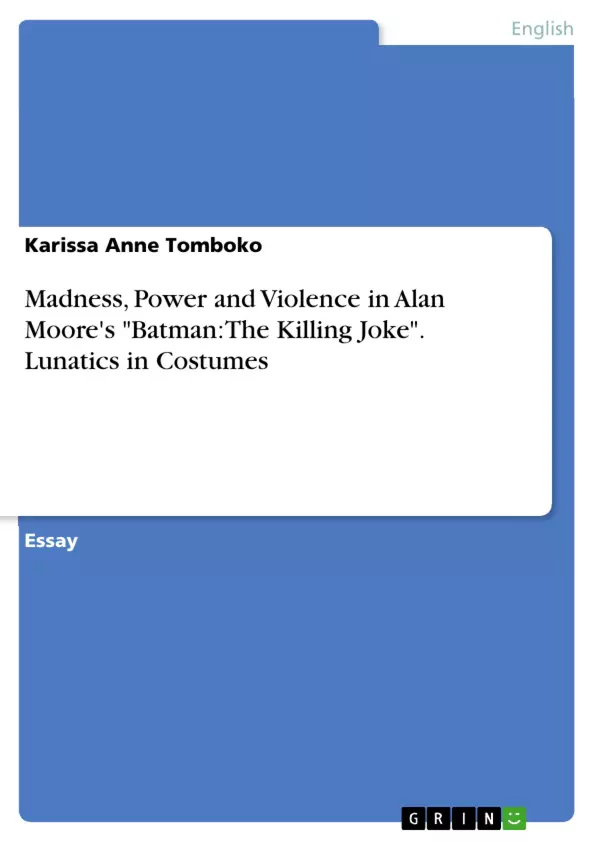Moore’s novel adds a new layer of perspective on the figure of the hero as well as on the villain - and thus blurs the strong contrast between the good and evil sides of both protagonists - resulting in a grey mélange. The picture of Batman which is nowadays portrayed in some graphic novels is extremely different from the two-dimensional superhero a few decades ago, and Moore’s work has its share in the psychological immersion. But how can we understand the major topics of madness, violence, and power which are common in all Batman comics and superhero franchises and especially in Alan Moore’s "Batman: The Killing Joke?". This question will be answered over the course of this essay.
Every reader of a Batman comic knows that in the end the superhero will finally defeat the bad guys and bring them to justice. Many fans of the series, therefore, claim that the stories in the universe of Batman are not interesting to read because Batman will win, but because of how he will win.
Alan Moore’s "Batman: The Killing Joke" is considered a milestone in the history of comics and graphic novel culture and is often referred to as one of the best graphic novels of all time. What makes the novel more special is that it "was actually supposed to be non-canon, but it was so impactful that it was incorporated into the DC Universe".
Moore provides the reader with the story of how an average nobody transformed into the villain who is throughout popular culture known as Batman’s greatest foe and the embodiment of chaos and destruction. It is revealed that Joker is the product of a sequence of tragic events that turn a loving and caring husband into a murdering psychopath who wants to hold up the mirror to the world and society. But the story goes way beyond that as it also sheds a light upon the way Batman feels for his opponent, how Barbara Gordon became the mastermind behind Batman’s high-tech and questions the way of how we as readers have to interpret the dazzling figure of the superhero Batman and his actions.
Inhaltsverzeichnis (Table of Contents)
- Introduction
- Madness
- Power
- Violence
Zielsetzung und Themenschwerpunkte (Objectives and Key Themes)
This seminar analyzes the graphic novel Batman: The Killing Joke by Alan Moore, exploring the themes of madness, power, and violence in the context of the Batman universe. The seminar aims to understand how Moore utilizes these themes to deconstruct the traditional superhero narrative and explore the gray areas of morality.
- The complexities of madness and its impact on both Batman and the Joker
- The interplay of power dynamics between Batman and the Joker, and their respective relationships with society
- The use of violence as a tool for control and manipulation by both protagonists
- The blurred lines between good and evil in the context of the Batman and Joker rivalry
- The exploration of societal institutions and their effectiveness in addressing crime and mental health
Zusammenfassung der Kapitel (Chapter Summaries)
- Introduction: This chapter introduces the concept of the "non-canon" graphic novel and its impact on the DC universe. It explores how Moore's Batman: The Killing Joke challenges traditional superhero narratives by portraying a darker and more complex portrayal of both Batman and the Joker.
- Madness: This chapter analyzes the concept of madness as it applies to both Batman and the Joker. It discusses the Joker's tragic backstory and explores the idea that Batman might be a "madman in a costume" due to his vigilantism and his obsession with fighting crime.
- Power: This chapter delves into the power dynamics between Batman and the Joker. It examines how the Joker uses chaos and manipulation to challenge Batman's sense of order and justice. The chapter also explores the Joker's belief that he cannot be cured and his desire to continue the game of cat and mouse with Batman.
- Violence: This chapter focuses on the role of violence in the relationship between Batman and the Joker. It analyzes how both characters use violence as a tool for control and intimidation. The chapter also discusses the Joker's use of extreme violence against Commissioner Gordon and his daughter, Barbara, to achieve his ultimate goal of breaking Batman.
Schlüsselwörter (Keywords)
The core keywords and topics in this analysis of Batman: The Killing Joke include: Batman, the Joker, madness, power, violence, graphic novels, superhero narratives, morality, societal institutions, crime, mental health, and the blurred lines between good and evil. Through these keywords, the seminar explores the complex themes and relationships presented in Moore's work, providing a comprehensive understanding of the graphic novel's impact on the Batman universe.
- Quote paper
- Karissa Anne Tomboko (Author), 2022, Madness, Power and Violence in Alan Moore's "Batman: The Killing Joke". Lunatics in Costumes, Munich, GRIN Verlag, https://www.grin.com/document/1315628



